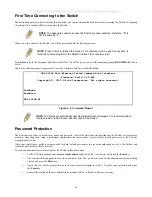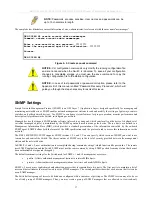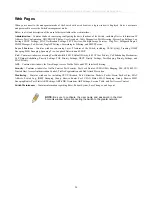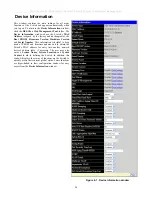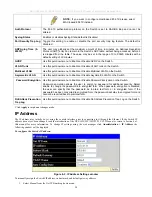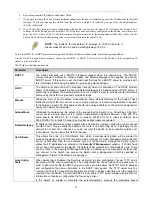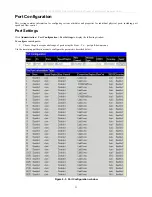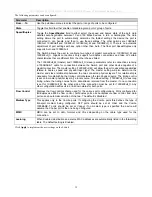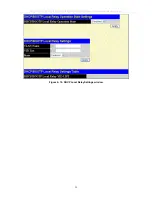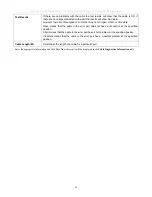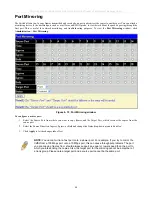
DES-3028 DES-3028P DES-3028G DES-3052 DES-3052P Layer 2 Fast Ethernet Managed Switch
29
2.
Enter the appropriate IP Address and Subnet Mask.
3.
If you want to access the Switch from a different subnet from the one it is installed on, enter the IP address of the Default
Gateway. If you will manage the Switch from the subnet on which it is installed, you can leave the default address
(0.0.0.0) in this field.
4.
If no VLANs have been previously configured on the Switch, you can use the
default
VLAN Name. The
default VLAN
contains all of the Switch ports as members. If VLANs have been previously configured on the Switch, you will need to
enter the
VLAN Name
of the VLAN that contains the port connected to the management station that will access the
Switch. The Switch will allow management access from stations in the same VLAN.
NOTE:
The Switch's factory default IP address is 10.90.90.90 with a
subnet mask of 255.0.0.0 and a default gateway of 0.0.0.0.
To use the BOOTP or DHCP protocols to assign the Switch an IP address, subnet mask, and default gateway address:
Use the Get IP From pull-down menu to choose from
BOOTP
or
DHCP
. This selects how the Switch will be assigned an IP
address on the next reboot.
The IP Address Settings options are:
Parameter Description
BOOTP
The Switch will send out a BOOTP broadcast request when it is powered up. The BOOTP
protocol allows IP addresses, network masks, and default gateways to be assigned by a central
BOOTP server. If this option is set, the Switch will first look for a BOOTP server to provide it with
this information before using the default or previously entered settings.
DHCP
The Switch will send out a DHCP broadcast request when it is powered on. The DHCP protocol
allows IP addresses, network masks, and default gateways to be assigned by a DHCP server. If
autoconfig is enabled, the Switch will first look for a DHCP server to provide it with information
before using the default or previously entered settings.
Manual
Allows the entry of an IP address, Subnet Mask, and a Default Gateway for the Switch. These
fields should be of the form xxx.xxx.xxx.xxx, where each xxx is a number (represented in decimal
form) between 0 and 255. This address should be a unique address on the network assigned for
use by the network administrator.
Subnet Mask
A Bitmask that determines the extent of the subnet that the Switch is on. Should be of the form
xxx.xxx.xxx.xxx, where each xxx is a number (represented in decimal) between 0 and 255. The
value should be 255.0.0.0 for a Class A network, 255.255.0.0 for a Class B network, and
255.255.255.0 for a Class C network, but custom subnet masks are allowed.
Default Gateway
IP address that determines where packets with a destination address outside the current subnet
should be sent. This is usually the address of a router or a host acting as an IP gateway. If your
network is not part of an intranet, or you do not want the Switch to be accessible outside your
local network, you can leave this field unchanged.
VLAN Name
This allows the entry of a VLAN Name from which a management station will be allowed to
manage the Switch using TCP/IP (in-band via web manager or Telnet). Management stations that
are on VLANs other than the one entered here will not be able to manage the Switch in-band
unless their IP addresses are entered in the
Security IP Management
window. If VLANs have
not yet been configured for the Switch, the default VLAN contains all of the Switch's ports. There
are no entries in the Security IP Management table, by default, so any management station that
can connect to the Switch can access the Switch until a management VLAN is specified or
Management Station IP Addresses are assigned.
Auto Config
State
When autoconfig is
Enabled
, the Switch is instructed to get a configuration file via TFTP, and it
becomes a DHCP client automatically. The configuration file will be loaded upon booting up. In
order to use Auto Config, the DHCP server must be set up to deliver the TFTP server IP address
and configuration file name information in the DHCP reply packet. The TFTP server must be
running and have the requested configuration file stored in its base directory when the request is
received from the Switch. Consult the DHCP server and/or TFTP server software instructions for
information on loading a configuration file for use by a client.
If the Switch is unable to complete the autoconfiguration process the previously saved
Содержание DES-3028
Страница 306: ......
Страница 307: ......
Страница 327: ...D Link D Link D Link D Link 7 495 744 00 99 http www dlink ru e mail support dlink ru...
Страница 332: ...Technical Support Web Web URL http www dlink jp com...


